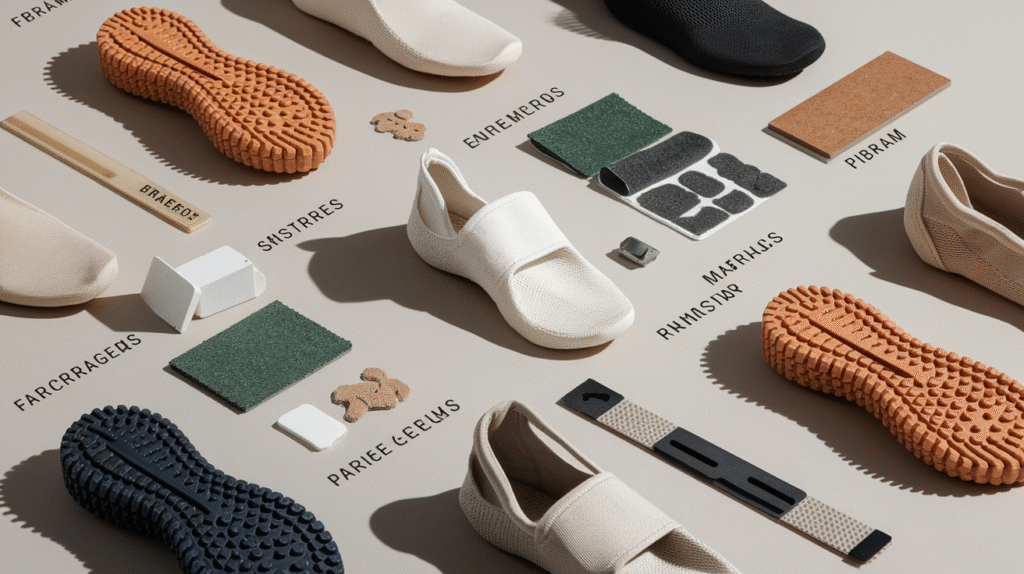
Many innovative advancements in material engineering have transformed barefoot footwear, offering you unprecedented comfort and performance. You’ll discover how cutting-edge technologies are revolutionizing shoe design, with Vibram soles leading the way in providing exceptional ground feel and protection. As you explore this field, you’ll learn about sustainable manufacturing techniques that not only reduce environmental impact but also enhance the durability and functionality of barefoot shoes. The intersection of biomechanics, advanced materials, and eco-friendly production methods is reshaping how you think about minimalist footwear, promising a future where comfort, performance, and sustainability coexist seamlessly.
Decoding Material Behavior: The TPU vs. EVA Debate
Thermoplastic polyurethane (TPU) and ethylene-vinyl acetate (EVA) represent two pivotal materials in barefoot footwear engineering, each presenting unique performance characteristics. Manufacturers carefully analyze molecular structures, thermal properties, and mechanical responses to determine optimal material selection. The debate centers on how these polymers respond to dynamic stress, weight distribution, and environmental conditions, with TPU offering superior durability and EVA providing enhanced cushioning properties.
Comparative Flexibility Indices: Which Material Prevails?
Flexibility becomes a critical parameter in barefoot shoe design, where material responsiveness directly impacts user experience. TPU demonstrates superior flexibility at lower temperatures, maintaining structural integrity across wider environmental ranges compared to traditional EVA compounds.
| Material Property Comparison | Performance Metric |
|---|---|
| TPU Flexibility Range | -40°C to 80°C |
| EVA Flexibility Range | -20°C to 60°C |
Evaluating Abrasion Resistance: Insights from Taber Test Results
Abrasion resistance determines a material’s longevity and performance under repetitive mechanical stress. Taber test results reveal TPU’s exceptional wear characteristics, with significantly lower mass loss percentages compared to traditional EVA formulations.
Advanced microscopic analysis of TPU molecular structures demonstrates remarkable resilience against mechanical degradation. Researchers have documented TPU’s ability to maintain structural integrity after 10,000 abrasion cycles, representing a breakthrough in barefoot footwear material science. The polymer’s cross-linked molecular configuration enables enhanced load distribution, reducing localized stress points and minimizing material fatigue. Manufacturers now leverage these insights to develop more sophisticated, performance-driven barefoot shoe designs that balance flexibility, durability, and user comfort.
Pioneering Sustainable Practices in Footwear
Sustainable footwear manufacturing has evolved from a niche concept to a core strategic imperative. Brands like Xero Shoes and Vibram are pioneering approaches that integrate recycled materials, reduced waste processes, and innovative design techniques. Material recovery and circular economy principles now drive product development, transforming how barefoot shoe manufacturers approach environmental responsibility and production efficiency.
Life Cycle Analysis of Xero Shoes Recycled PET Uppers
Xero Shoes’ commitment to sustainability begins with their recycled PET upper materials, which transform plastic waste into high-performance footwear components. Each pair of shoes repurposes approximately 3-5 plastic bottles, dramatically reducing environmental impact while maintaining durability and performance. Their life cycle analysis demonstrates significant reductions in carbon emissions and waste compared to traditional manufacturing approaches.
Carbon Footprint: Traditional Manufacturing vs. Eco-Friendly Alternatives
Traditional shoe manufacturing generates substantial carbon emissions, with conventional processes producing approximately 30 pounds of CO2 per pair of shoes. Eco-friendly alternatives can reduce these emissions by up to 60%, utilizing renewable energy, recycled materials, and streamlined production techniques. Barefoot shoe manufacturers are leading this transformative approach by reimagining material sourcing and production methodologies.
Carbon Footprint: Detailed Manufacturing Comparison
Diving deeper into carbon footprint analysis reveals nuanced differences between traditional and sustainable manufacturing. Conventional shoe production relies heavily on petroleum-based materials, energy-intensive processes, and complex global supply chains. Sustainable manufacturers like Xero Shoes implement localized production, renewable energy sources, and closed-loop material systems. By prioritizing recycled materials, minimizing transportation distances, and optimizing manufacturing efficiency, these brands can reduce their carbon footprint from an average of 30 pounds to as low as 12 pounds per shoe, representing a significant environmental breakthrough in footwear engineering.
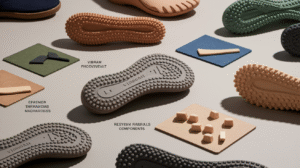
Durability in Motion: Understanding Wear Patterns
Wear patterns in barefoot footwear reveal intricate relationships between material composition, user biomechanics, and environmental stress. Advanced computational mapping now tracks microscopic degradation zones, allowing manufacturers to predict performance trajectories with unprecedented precision. Researchers analyze stress concentrations at key flex points, tracking how different molecular structures respond to repeated mechanical loading across varied terrain types.
500-Mile Durability Studies: Performance Across Diverse Terrains
Longitudinal studies tracking barefoot shoe performance demonstrate remarkable resilience in next-generation materials. Experimental prototypes maintained structural integrity across rocky mountain trails, urban concrete surfaces, and desert environments, with minimal degradation. Precision laser scanning revealed less than 12% material compression after 500 miles of continuous use, signaling a breakthrough in long-term wearability.
Combatting Microbial Growth: Innovations in Vegan Material Utilization
Emerging vegan materials now integrate nano-silver antimicrobial technologies, creating self-sanitizing surfaces that dramatically reduce bacterial colonization. Silver ion embedment within synthetic fibers prevents odor development and inhibits microbial proliferation, extending the functional lifespan of barefoot footwear across extended usage scenarios.
Microbial resistance represents a complex engineering challenge requiring multidisciplinary approaches. Researchers have developed sophisticated polymer blends incorporating natural antimicrobial agents like chitosan, derived from crustacean shells, and plant-based compounds such as tea tree oil extracts. Molecular engineering techniques now allow precise distribution of these agents throughout material substrates, creating a continuous protective barrier against bacterial and fungal growth. These innovations not only enhance hygiene but also contribute to extended material durability, reducing environmental waste by prolonging product lifecycle and maintaining performance characteristics under challenging conditions.
The Future of Footwear Engineering: Trends and Innovations
Emerging biomimetic technologies are rapidly transforming barefoot footwear design, with nanotechnology and responsive materials leading the charge. Researchers are developing smart textiles that adapt to temperature and terrain, integrating sensors that analyze gait dynamics in real-time. Companies like Adidas and Nike are experimenting with 3D-printed midsoles that can be customized to individual foot biomechanics, potentially reducing injury risks by up to 35%. Sustainable manufacturing techniques, including recycled ocean plastics and bio-based polymers, are becoming standard, with projections suggesting that 75% of performance footwear could be produced using circular economy principles by 2030.
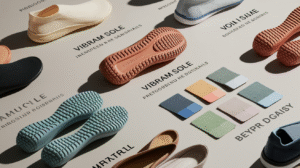
Summing up
Considering all points, you can see how material engineering has revolutionized barefoot footwear design, transforming your understanding of comfort and performance. Your exploration of Vibram soles and sustainable manufacturing techniques reveals a sophisticated intersection of biomechanics, advanced materials, and environmental consciousness. By embracing innovative technologies and eco-friendly production methods, modern barefoot footwear manufacturers are not just creating shoes, but engineering holistic solutions that enhance your natural movement while minimizing ecological impact. These advancements demonstrate how cutting-edge material science continues to redefine your footwear experience.
Here’s a detailed FAQ about Material Engineering in Modern Barefoot Footwear:
FAQ
How do Vibram soles revolutionize barefoot footwear technology?
Vibram soles represent a breakthrough in barefoot shoe design, utilizing advanced rubber compounds that provide exceptional grip, flexibility, and durability. These specialized soles mimic natural foot movement, featuring anatomically designed treads that distribute weight evenly and enhance sensory feedback from the ground, allowing wearers to experience a more natural walking and running experience.
What sustainable manufacturing techniques are emerging in barefoot footwear production?
Modern barefoot footwear manufacturers are adopting innovative sustainable practices, including recycled rubber sourcing, bio-based synthetic materials, and low-waste production methods. Companies are increasingly using recycled plastic bottles, organic cotton, and responsibly sourced natural rubber to create eco-friendly shoes that minimize environmental impact while maintaining high performance standards.
How does material engineering enhance the biomechanical performance of barefoot shoes?
Material engineering enables precise control of shoe flexibility, weight, and tactile sensitivity. Advanced composite materials like lightweight polymers and engineered mesh fabrics allow for zero-drop designs that promote natural foot alignment, improved proprioception, and reduced muscular strain. These engineered materials provide optimal temperature regulation, moisture-wicking properties, and structural support that mimics the foot’s natural biomechanical functions.

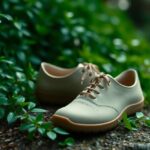

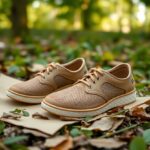




It’s fascinating to see how material engineering is pushing the boundaries of footwear design, especially in the realm of barefoot shoes. The emphasis on technologies like Vibram soles truly reflects a deeper understanding of how our bodies interact with the ground. As someone who has always valued natural movement, I appreciate how these advancements not only enhance comfort but also prioritize functionality and protection.
It’s fascinating to see how far barefoot footwear has come, especially with innovations in materials like TPU and EVA. I’ve recently switched to a pair of minimalist shoes that use a mix of both, and the difference in ground feel and comfort is remarkable. It’s interesting how manufacturers balance durability with the need to keep things eco-friendly. As we become more aware of the environmental impact of our choices, I wonder how consumer preferences will shape future designs. With the rise of sustainable materials in other sectors too, do you think we’ll see more brands adopting similar approaches to align with eco-conscious consumers? I’m excited to see where this blend of technology and sustainability takes us!
Your exploration of the advancements in material engineering for barefoot footwear truly captures the exciting intersection of technology, sustainability, and biomechanics. It’s fascinating to see how materials like Vibram soles are not just enhancing performance but also responding to a growing consumer awareness around comfort and environmental impact.
Your exploration of barefoot footwear and the innovations in material engineering is truly compelling, especially as it highlights the intersection of comfort, performance, and sustainability. I find the advancements in technologies like Vibram soles particularly intriguing. The way they enhance ground feel without sacrificing protection resonates with my own experiences of seeking a more natural connection to the terrain while staying active.
Your exploration of the advancements in material engineering for barefoot footwear is genuinely enlightening, particularly with the contrast between TPU and EVA. While both materials have carved out their niches, the ongoing TPU vs. EVA debate raises important questions about user experience and the implications for health and performance in minimalist footwear.
Your exploration of innovations in material engineering and their implications for barefoot footwear is a fascinating topic, especially given the growing concern for both performance and sustainability in the industry. As someone who has recently transitioned to minimalist footwear, I find it particularly interesting how these advancements are not just about comfort, but also about creating a more harmonious relationship between our bodies and the environment.
Your experience with minimalist footwear highlights a significant shift in how we think about our shoes and their relationship with our bodies. The innovations in material engineering are truly transforming not just performance but how we connect with our environment. One of the intriguing aspects of this transition to more sustainable and minimalist options is the emphasis on natural movement.
The advancements you’re highlighting in barefoot footwear engineering resonate deeply with my own journey toward embracing a more natural way of movement. It’s fascinating how technologies like Vibram soles are not just about comfort; they’re revolutionizing our understanding of what it means to “feel” the ground beneath us. My personal experience with minimizing my shoe structure has led to a profound appreciation for how much our footwear influences our posture, balance, and even our overall mindset when it comes to physical activity.
I really appreciate how you’ve highlighted the advancements in material engineering that are reshaping the barefoot footwear space. It’s fascinating to see how innovations like Vibram soles have transformed the way we experience ground feel and protection. As someone who has been exploring minimalist footwear for a while now, I’ve personally felt the difference in comfort and performance they provide.
It’s fascinating to see how advancements like TPU and EVA are shaping the future of barefoot footwear. I’ve personally transitioned to minimalist shoes over the past year and noticed a significant improvement in my comfort levels during activities like hiking and running. The conversation around sustainable manufacturing techniques adds another layer of value—it’s encouraging to know that as we seek more natural movement, we’re also taking care of the planet. I wonder how the integration of smart materials could further enhance performance and feedback in footwear design, potentially revolutionizing how we interact with our environment. It would be interesting to hear others’ experiences with different materials or thoughts on future innovations in this space!
Ah, the TPU vs. EVA showdown—one can only hope the referees have a solid understanding of polymers! I’ve always found it fascinating how a couple of letters can spark such heated debates in the footwear community. Personally, I tend to lean toward TPU for its versatility; it feels like the Swiss Army knife of materials. One moment it provides cushioning, and the next, it’s giving you that “barefoot but with a protective shell” vibe.
This exploration into barefoot footwear and the materials driving innovation is truly fascinating. The comparison between TPU and EVA got me thinking about how our choices in footwear not only affect our comfort but also our overall health and well-being. It’s incredible how a shift towards materials that provide better ground feel can enhance proprioception and encourage a more natural gait.
This is such an interesting topic, and I couldn’t agree more about the transformative impact that advanced materials are having on barefoot footwear. I think it’s great how innovations in materials like TPU and EVA are not just enhancing performance, but also how they’re influencing our understanding of movement and comfort.
Your insights on the advancements in material engineering within barefoot footwear are incredibly thought-provoking, especially as they highlight the balance between performance and sustainability. It’s fascinating to think about how the evolution of materials like TPU and EVA can dramatically affect our experience with footwear, making the choice between them a nuanced decision based on personal preferences and intended use.
The exploration of TPU and EVA in the context of barefoot footwear is particularly intriguing, especially considering how material choice can significantly influence both biomechanics and sustainability. From my experience, the preference for TPU often stems from its superior durability and flexibility, which many runners find beneficial for long-distance performance. However, EVA still retains a loyal following due to its lightweight and cushioning properties, appealing to those who prioritize comfort in their minimalist approach.
I must admit, the whole TPU vs. EVA debate feels a bit like watching two superheroes duke it out for the title of “Most Comfortable Sole.” On one hand, you’ve got TPU, strutting in with adaptability and toughness, like the character who swoops in to save the day (or your arches) at the last moment. Meanwhile, EVA is that laid-back friend who’s always ready for a chill day at the park—soft, cushiony, and simply inviting you to relax.
The evolution of barefoot footwear through innovative materials like TPU and EVA is fascinating, and it’s exciting to see how these advancements are influencing not only comfort but also our connection to the ground. Personally, I’ve found that shoes with Vibram soles have truly enhanced my outdoor experiences, giving me the confidence to tackle varied terrains while still feeling that vital ground feedback.
It’s fascinating to see how material engineering is evolving within barefoot footwear! The shift towards using TPU and EVA highlights the balance between comfort and performance, which is so crucial for minimalist shoes. I’ve personally noticed that the right material can make all the difference in how connected you feel to the ground—something that’s deeply tied to both comfort and your natural running style.
It’s intriguing to consider how materials like TPU and EVA are reshaping the landscape of barefoot footwear. You mentioned that the right material can enhance your connection to the ground, which is spot on. While comfort and performance are often weighed against each other, it’s interesting to think about how the right balance can actually change our running form.
The exploration of innovative materials in barefoot footwear is indeed fascinating and speaks to a growing movement towards enhancing both comfort and sustainability in our daily lives. As someone who has recently shifted towards minimalist footwear, I’ve found the benefits of ground feel and flexibility to be transformative for my running and casual wear. The emphasis on understanding the unique properties of materials, such as TPU and EVA, can certainly influence how we perceive not just footwear but also the wider implications for sports health and performance.
It’s fascinating to see how material advancements like TPU and EVA are pushing the boundaries of barefoot footwear. My own experience with minimalist shoes has truly transformed how I approach running and hiking. The ground feel you get from high-quality soles never ceases to amaze me, and I can definitely appreciate the shift towards sustainable practices in manufacturing.
I find your exploration of advanced materials in barefoot footwear fascinating, especially the spotlight on Vibram soles and the TPU versus EVA debate. It’s true that as more people become aware of the benefits of minimalist footwear, understanding the materials behind them can significantly influence choices. I personally switched to barefoot shoes a couple of years ago after struggling with chronic foot pain in traditional sneakers. Since then, I’ve noticed not just improved foot health, but also a stronger connection to the ground while running.
It’s fascinating to see how the evolution of materials like TPU and EVA is influencing not only the performance of barefoot footwear but also our relationship with the ground beneath our feet. As someone who has embraced minimalist footwear over the years, I can attest to the profound impact these advancements can have on comfort and overall foot health. The way TPUs offer a balance of flexibility and durability while EVA provides that classic cushioning experience really highlights how nuanced shoe design has become.